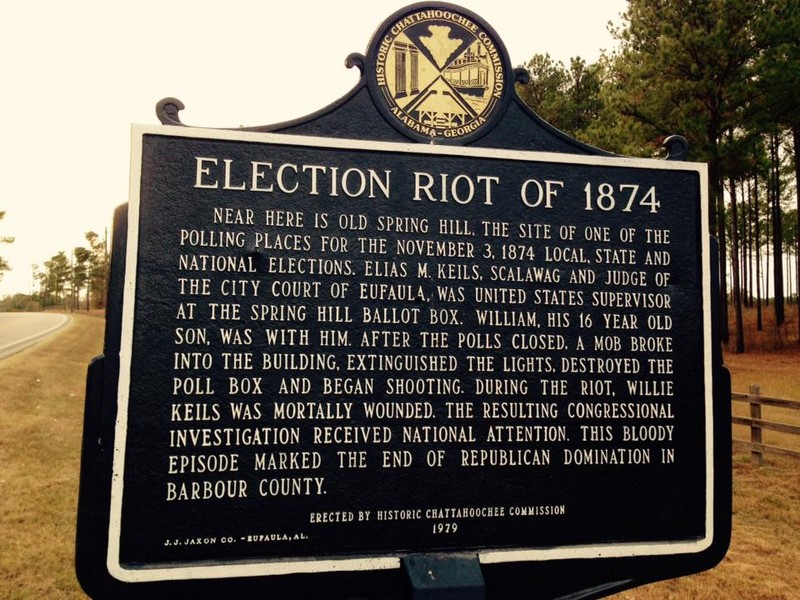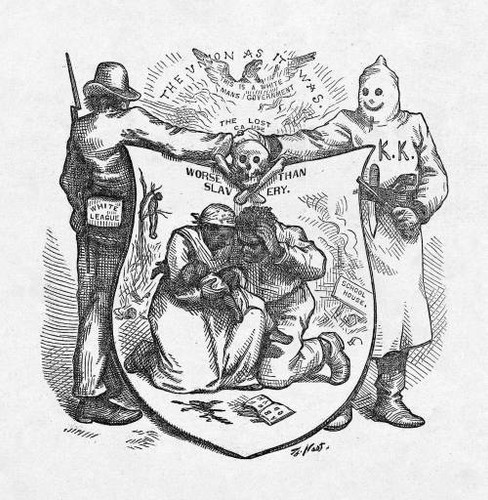Election Riot of 1874 Marker
Introduction
Text-to-speech Audio
This historical marker was erected by the Historic Chattahoochee Commission in 1979 and offers a disturbingly neutral interpretation of the violence perpetrated by white supremacists who launched a violent coup that allowed them to seize power through force rather than allow all voters to participate in the elections in 1874. White supporters of the local Democratic Party, recognizing that most Black voters supported the Republicans, organized a paramilitary organization known as the White League and attacked dozens of would-be voters on election day. The violence began near Eufala, where White Leaguers shot and killed at least seven Black men and injured seventy more. The mob then moved to Spring Hill and attacked the poling place, killing the son of a Republican judge who happened to be present. Federal troops helped to end the violence, but the federal government did not reverse the results of the fraudulent election. The result was the elimination of the Republican Party in Barbour County and the end of African American voting rights until the passage of the 1964 Civil Rights Act.
Prior to this violence, the Republican Party won many local offices through a coalition of Black and white voters who hoped to reform the political system and promote education and industry. The elimination of the Republican Party effectively ended Black political participation and solidified the power of white landowners who controlled the Democratic Party.
The violence against Black and white Republicans that occurred here in 1874 was commonplace thorughout the South in the 1870s. This particular "riot" led to a Congressional investiagion because one of the victims was William Keils, a 16-year old white boy and son of a judge. The investigation followed partisan lines, with Democrats claiming that the White League was merely acting in self-defense against an "army" of violent Black men who planned to steal the election. The Republican leaders in Congress called for more federal oversight of elections. However, white voters throughout the nation had grown tired of hearing about the plight of former slaves and turned against the Republican Party. With the Democrats controlling Congress, federal troops and officials were removed from the South and white paramilitary organizations and their accomplices seized power throughout the South. Few Black Southerners were able to vote owing to the threat of violence and a variety of laws that effectively barred African Americans from the polls until the Civil Rights Act of 1964.
Images
Photo by Matt Stanley

"The Union as it Was" This 1874 political cartoon from Harper's Weekly depicts the cooperation Klan members and White Leagers as they used violence to reverse the gains African Americans had made with the end of slavery.

Backstory and Context
Text-to-speech Audio
Those familiar with the history of Reconstruction will recognize phrases used in this marker such as "end of Republican domination" and "scalawag" as phrases that were often used by historians who defended the mobs in the early 20th century. As a result, this sign was likely the result of poor historical research rather than an deliberate attempt to normalize racial violence and the overthrow of democratic government.
Similar to many historical markers related to uncomfortable events in history, the language of this sign minimizes the one-sided violence perpetrated by white supremacists. This sign is particularly egregious as it fails to mention race altogether. The sign refers to Republican judge Elias Keils, who was killed for his attempt to allow Black voters to participate in the election, as a "scallawag." This contemporary insult was applied by Southern whites to other Southern whites who supported the rights of former slaves. For those who lived during this era of Reconstruction, "scallawag" was tantamount to calling someone a traitor to the white race.
Although a handful of Black men were armed, the white vigilantes planned and coordinated their attack, utilizing hidden a caches of weapons to overwhelm the would-be Black voters. Throughout Barbour County, members of the White League and other white supremacist paramilitary groups attacked Black residents, prevented them from voting, or simply burned their ballots. The small number of federal troops moved to restore order, but did not challenge the results of the election.
Similar to many historical markers related to uncomfortable events in history, the language of this sign minimizes the one-sided violence perpetrated by white supremacists. This sign is particularly egregious as it fails to mention race altogether. The sign refers to Republican judge Elias Keils, who was killed for his attempt to allow Black voters to participate in the election, as a "scallawag." This contemporary insult was applied by Southern whites to other Southern whites who supported the rights of former slaves. For those who lived during this era of Reconstruction, "scallawag" was tantamount to calling someone a traitor to the white race.
Although a handful of Black men were armed, the white vigilantes planned and coordinated their attack, utilizing hidden a caches of weapons to overwhelm the would-be Black voters. Throughout Barbour County, members of the White League and other white supremacist paramilitary groups attacked Black residents, prevented them from voting, or simply burned their ballots. The small number of federal troops moved to restore order, but did not challenge the results of the election.
Sources
Hennessey, Melinda M. "Reconstruction Politics and the Military: The Eufaula Riot of 1874," Alabama Historical Quarterly 38 (Summer 1976): 112-125.
Blake Willhelm, "Election Riots of 1874." Encyclopedia of Alabama, November 6, 2009. (Accessed 11/28/16). http://www.encyclopediaofalabama.org/article/h-2484
